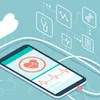How technology is advancing India’s testing conditions
In this article, we will examine the medical care innovation patterns for the year 2021, and perceive how each of these advances will shape the clinical business in the short term.
India is one of the fastest-developing nations. With the help of technology innovation, it is probably going to make both huge monetary benefits and change the idea of work for Indians.
This brief inspects the key boundaries and advancements that administer the Indian healthcare systems -- telemedicine, medical cybersecurity, patient records, virtual consultation, and more. It also tracks down the specific components that are essential in fostering strong vital testing conditions.
Technology has played a vital role in enhancing the condition of India as well as fostering overall growth of the country. From having the option to smooth out their activities with the assistance of medical cybersecurity innovation to testing patients through telemedicine, there is a lot that medical care associations can do to improve themselves by utilising innovation.
Today, hospitals and clinics are using technology to test COVID-19. Even for testing new medications and the effect on the human condition, technology and its devices are being praised.
In this article, we will examine the medical care innovation patterns for the year 2021 and perceive how each of these advances will shape the clinical business in the short term. We will, likewise, introduce the types of medical technology techniques used to leverage the growth of the healthcare industry.
How technology has leveraged COVID-19 testing conditions?
During the pandemic, technology has made a significant contribution by providing Rapid Testing of patients. With a population of nearly 1.4 billion, this is extremely useful in a country like India as it sometimes gets difficult to test each patient in a limited time.
Through the surveillance of technology, Rapid Testing is identified as a boon and care to numerous patients in India.
Internet of medical things
The applications that are associated with medical services with the assistance of online networks comprises of Internet of Medical things (IoMT). IoMT is an interconnected software application that helps in diagnosing the disease more accurately and testing the possibilities of diseases.
With the assistance of interconnected softwares, which helps in gathering, analysing, testing, and sending information to medical organisations, these devices are a vital shift to new models of healthcare such as PHM.
Apparently, there has been a colossal improvement in understanding consideration and smoothing out of the clinical work process for the executives.
Digitisation of patient’s records
Digitisation of patient’s records is required to assume a huge part in giving better admittance to medical administrations and associations.
India is, as of now, in the underlying period of this turn of events, and is wanting to carry out the creative e-clinics programmes, which are pointed toward furnishing the doctors with better data on their patients' clinical history. By this method, doctors will be easily able to obtain data and perform the experiments to efficiently test the on-going conditions of the patient.
The digitisation of patient records creates more opportunities for doctors, specifically to search instantly to have clear patient information from automated medical suggestions to noting down the important description for further analytical testing.
With this increasingly powerful innovation, health records are now efficient to maintain.
Telemedicine
Telemedicine is a remote delivery healthcare service, which is used to diagnose and treat the patients remotely.
It ordinarily occurs through video meetings and is utilised by the medical care experts to examine the medical condition of the patient. While it’s anything but another wonder, the ratio of telemedicine has expanded immeasurably due to higher demand.
After sharing the medical history and other side effects of the patient, the distant patient will be associated with a clinician for the assistance. In light of the clinician’s assessment, the call will end with the patient getting further directions to assume control over-the-counter medicine, to do the test of necessary things, and go to a clinic or timetable a subsequent arrangement.
Wearable devices
Sensors that are attached to these devices are innovative solutions for testing a patient's condition. These devices empower the consistent testing and monitoring of human conditions and activities. The most usually estimated information incorporates signs, for example, pulse, blood pressure, oxygen level, body measurements and posture and more.
There are two significant kinds of wearable gadgets that are utilised for examining and testing health conditions. Few of them have been produced for medical experts to consistently monitor walking patterns of humans, while the others are designed for humans to measure the regular check-ups of their body.
Conclusion
The encounters of effective India shows that innovation and advancement approaches that are coordinated into healthcare can assist with raising usefulness in testing conditions, further develop awareness, and encourage financial development.
For India, different drives have pushed the country up in the worldwide development record. Vital endeavours are needed for invigorating the advancement of healthcare for empowering multipolar and problematic developments of testing conditions to meet the powerful economic situations, urbanisation needs, and natural manageability.
Edited by Megha Reddy
(Disclaimer: The views and opinions expressed in this article are those of the author and do not necessarily reflect the views of YourStory.)









